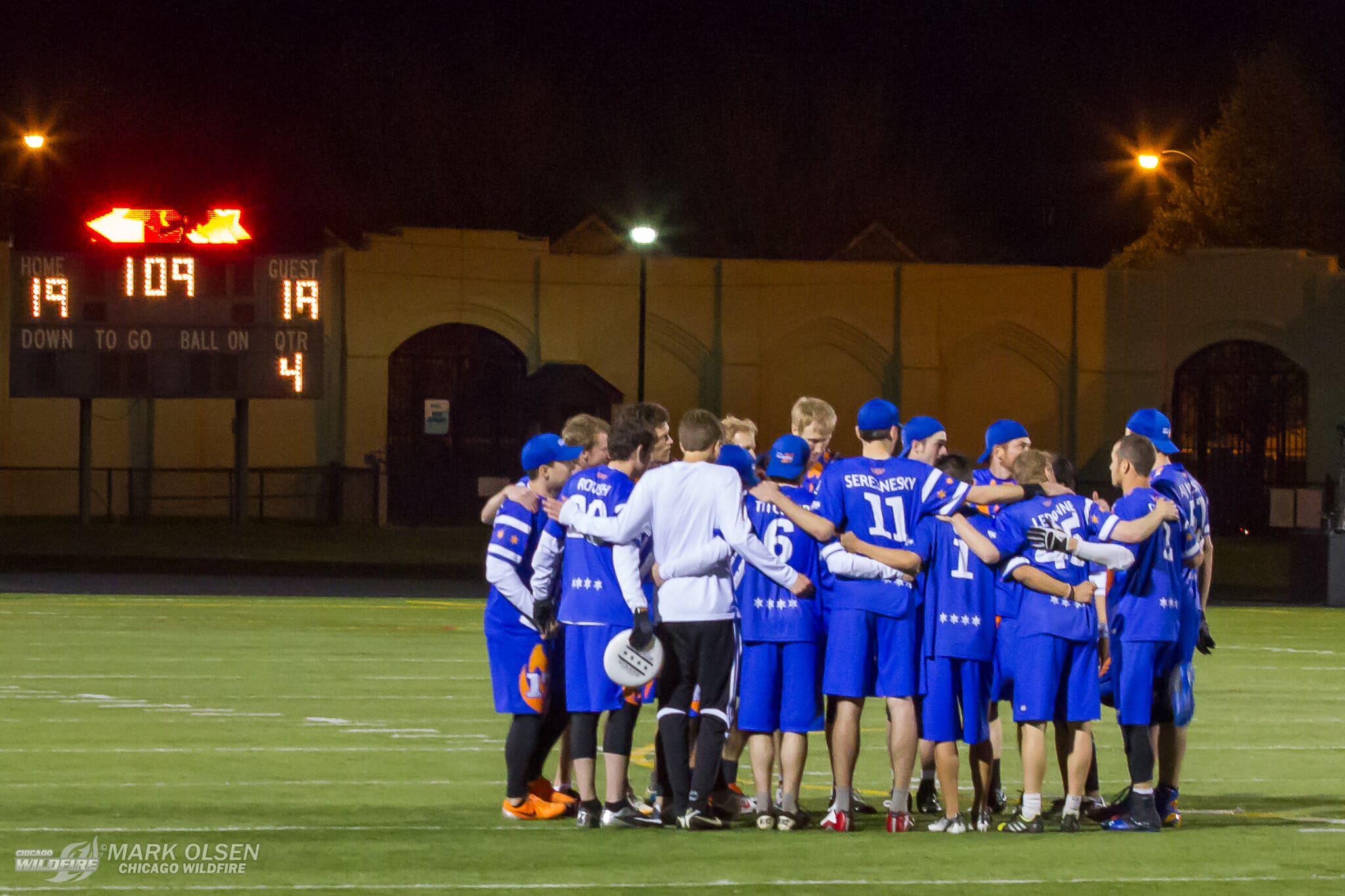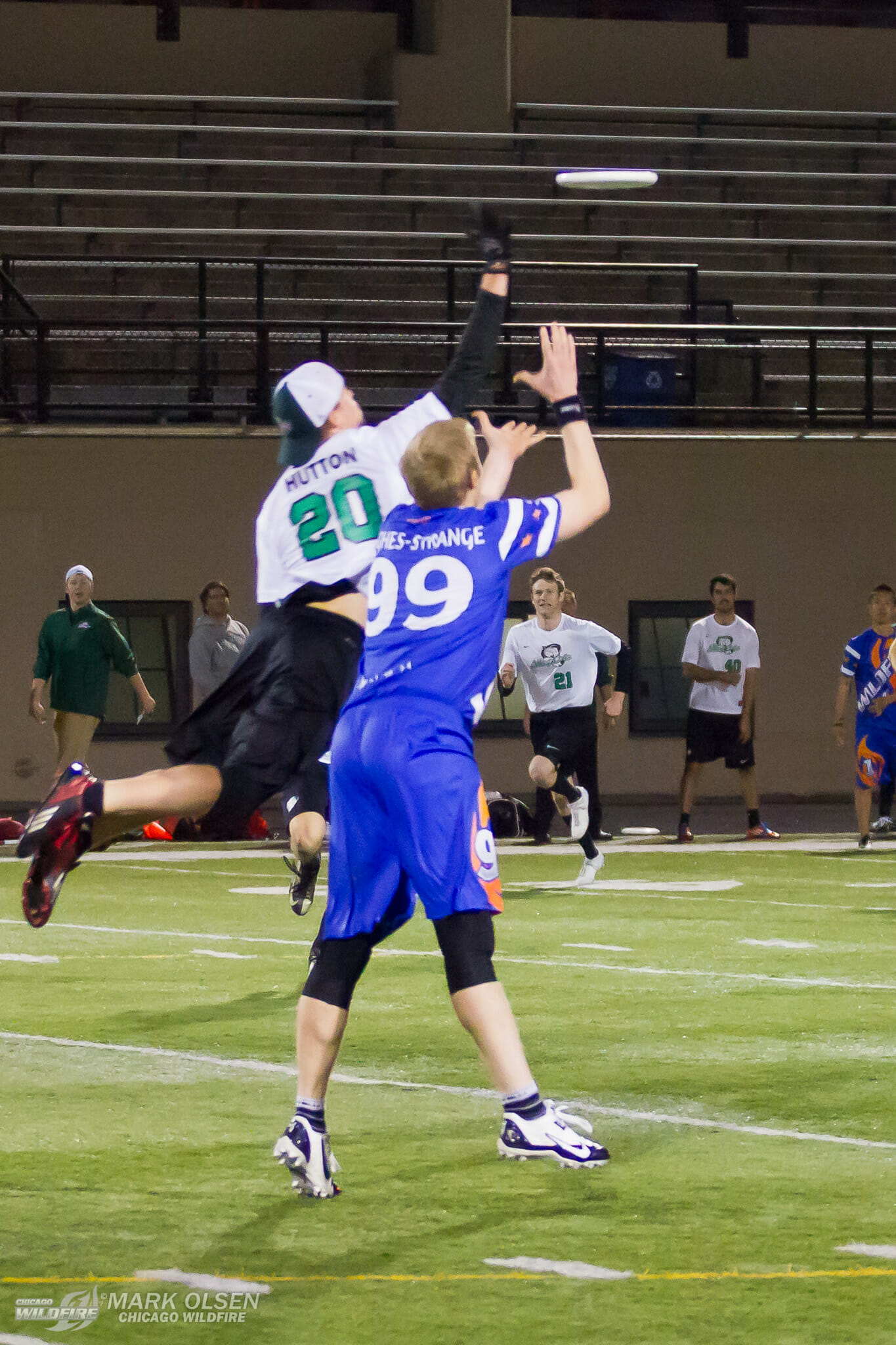May 13, 2014 by Katie Raynolds in News, Recap with 5 comments

Two weeks ago, the Chicago Wildfire tasted bitter defeat on the road against the Indianapolis AlleyCats. The loss followed a loss the night before to the Cincinnati Revolution, leaving Wildfire in a very different place than where they had entered the season.
ESPN3 broadcast the Friday rematch against the Indianapolis AlleyCats, and the Wildfire spent the week before the game maniacally hyping the game, with discounted ticket prices and rabid Facebook posting from the players. Their efforts paid off: compared to the 57 – yes, 57 – people at the Detroit Mechanix game the week before, over 400 people showed up last Friday, and I caught a glimpse of how these pro teams imagine their own futures: fans cheering, gasping, and heckling at all the right moments.
The AlleyCats came out hot to score first and took an early lead, 4-1. Cameron Brock, Keenan Plew, and Joey Cari made up most of the AlleyCats’ midfield, and their offense relied on completing every 10-yard throw rather than completing the 40-yard punt that generates the big plays.
In elite men’s ultimate, it’s easy to assume that the best player on the team makes the biggest plays. I expected to see the biggest plays from Brock and Plew, but they frankly played better Ultimate than that: they were open for almost every under throw they wanted, and their tireless cutting gave the handlers An Toine, Kyle Cox, and Brian Ventura options everywhere on the field.
AlleyCats veteran Travis Carpenter agreed: “Our motto is, ‘What we don’t do on offense, what we do on defense.’ We’re looking to have conservative offense with smart throws, and we have the cutters that can make the throws upfield so we like to get them the disc early and often…we just try to run defenses into the ground.”
Wildfire shook off the nerves early, and they were able to break back effectively to end the first quarter 3-5. Wildfire’s approach to the different AUDL rules — legal double teams and a huge field — has been simple: put your battle-tested veterans in the backfield, and let them throw whatever they want. Ron Kubalanza, Bob Liu, and Andy Nielsen were their primary offensive weapons with Dan Williams, Walden Nelson, and Xtehn Titcomb stepping in. The new AUDL rules seem designed to let Bob Liu make defenders look silly: his throws can and do go wherever he decides. Ron Kubalanza, on the other hand, has played for so long and at so many levels that no amount of rule changes or defenders could change how he handles.
The second quarter was Wildfire’s to take. Both teams traded points to start, but Wildfire’s rookies worked hard on defense to give Goose opportunities on offense, and he rewarded the effort with long looks and patient endzone offense that helped Wildfire reach 10-7.
Indianapolis maintained their patient offense, but the strategy that relied on myriad touches also gave the amped-up Wildfire more opportunities to force fumbles or generate turns. Dan Williams’ name doesn’t come up often in previews, recaps, or even Wildfire’s promotional materials, but it should: the man was sacrificing his body for layout Ds 5 minutes into the game, playing rabid defense and composed offense every time he was on-field. When he wasn’t on, he was engaging with the crowd, demanding with his energy that the stadium match his excitement.
Wildfire maintained their lead through most of the second quarter, letting the AlleyCats sneak a point in before half on a long put to Joey Cari from David Valentine-Elam. This point and a long half should have given the AlleyCats a chance to refocus, but they came out of half on their heels, and Wildfire was able to score twice from Indianapolis mistakes to make the score 13-9.

The AlleyCats continued to claw back, and play got physical as each team sought to shut down each other’s playmakers. The AlleyCats matched up well against Wildfire’s biggest threats, putting height on AJ Nelson and putting experience on Goose Helton. Carpenter describes their strategy as one of containment: “We tried to make them be patient. We know that they like to huck it because of their good throwers and their big receivers, so we tried to make them be as patient as possible and swing it a lot before they scored.”
Through hard-fought points, Wildfire managed to end the third quarter 15-13, with Indianapolis close on their heels. But nobody realized that this game hadn’t even begun.
The Indianapolis AlleyCats had been trying to muster energy all game, despite having no hometown fans to mirror their cheers and their enthusiasm. For the first point of the fourth quarter they traded turns with Wildfire until David Valentine-Elam pitched a lengthy forehand into the endzone to Brock, who tipped the throw and then plunged to the ground to save the disc.
The AlleyCats erupted, but the referee called the disc down, and you could see the injustice settle on their shoulders1. So when they were able to regain possession for an open look to Luke Broderick, the AlleyCats didn’t just score: they reclaimed the intangible yet all-important disc karma that they knew they deserved.
Wildfire responded in kind: Bob Liu handblocked AlleyCats handler Jason Yoder before sending a casual hammer to Walden Nelson in the endzone, much to the crowd’s delight. The teams fed off each other’s momentum, trading huge plays until the score was 17-17. The final point stretched on with impressive defensive plays from Jason Yoder and Goose Helton that were followed by desperate late-game looks to AJ Nelson and George Hughes-Strange.
AJ Nelson remembers that point, saying “I almost cried; it was the end of regulation, I was right there…it’s gonna haunt me.”
Despite copious brochures that effectively spell out the unique AUDL rules, most fans in the crowd knew few of the nitty-gritty distinctions between the game in front of them and the game they knew. Double teams were okay, but what about triple teams? What’s the stall? Why did that guy just walk with the disc? What can they contest? These questions peppered the bleacher discussions, but they didn’t seem to influence fans’ experience of the game until the final quarter ended, and nobody knew what happened next.
Per the AUDL rules, both teams would go into a 5-minute overtime that they would play in full. If the score remained tied after the overtime was threw, then both teams would go into a second overtime that would be sudden death.
Although it would be untenable, I think a lot more people would watch the AUDL if whole games looked like that overtime. Plays got big: Bob Liu bid wildly in the endzone for a score that would be recalled by the referees and that would send him out of the game with an injury. The AlleyCats scored after a foul call in their endzone: 19-18. Goose Helton stretched for the disc near the endzone, but Jason Yoder took him out mid-jump to raucous boos. Helton appeased the crowd with a kip-up and a high-release backhand to AJ that tied the game at 19-19.
The last point stretched through the final minute of overtime: a floaty turn from the AlleyCats gave Wildfire possession, and they took a timeout. Liu sent yet another hammer cross-field to a waiting Hughes-Strange, but Brian Ventura won his team another shot on a massive layout D. Indianapolis took a timeout with 14 seconds left in overtime. The seconds disappeared as Plew threw a longer look to Valentine-Elam, but he wasn’t able to complete the score.
The Wildfire and the AlleyCats headed into a sudden-death second overtime, with Wildfire pulling to the AlleyCats. The AlleyCats began the point with efficient, smart handling across the field, but Travis Carpenter failed to snag a floaty pass, and Kramer took the disc down for Wildfire close to their endzone. Quick work from Wildfire found AJ Nelson on an up-line score for the game, the win, and the second spot in the Midwest Division.
This game was a brief and vivid snapshot of what the AUDL teams across the country strive for: big plays, crowded stands, money filling the cash-box. That Wildfire had to heavily discount their tickets to draw this crowd didn’t help, but I understand better what the league envisions. Whether or not they’ll get there rests on a complicated set of economic and political factors, but last Friday at least, Chicago got to watch some damn good ultimate.
It was down. But I’m sure it was still demoralizing. ↩